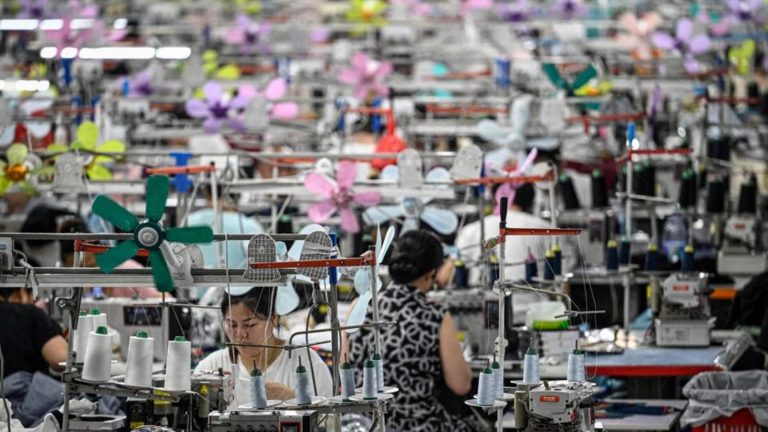Young men who chose fast fashion in FY2024 wore oversized t-shirts, graphic t-shirts, printed shirts, and cargo pants. The next major fashion trend for them is likely to be coordinating sets and all-time jackets. Millennial and Gen Z women are expected to buy dresses, co-ords and wide-leg pants in 2024, with shapewear expected to be the next big thing, according to a new report from Redseer Strategy Consultants. In FY24, India’s fast fashion sector grew at 30-40%, while the larger apparel sector grew at only 6%. The country’s $10 billion fast fashion sector will reach $50 billion in seven years, the report says.
This photo taken on June 11, 2024, shows workers producing clothing at a textile factory that supplies clothing to fast fashion e-commerce company Shein in Guangzhou, southern China’s Guangdong province. (Photo by Jade GAO/AFP) (AFP)
Fast fashion is different from regular or traditional fashion brands, which release collections three to four times a year depending on the season. Fast fashion refers to fast-moving clothing that is quickly introduced to the market based on trends. According to the report, fast fashion companies release more than 50 collections a year and are in perpetual production mode to always provide consumers with the latest designs and styles.
Kushal Bhatnagar, associate partner at Redseer Strategy Consultants, said fast fashion is currently the growth lever for the fashion industry. “Besides global brands like ZARA and H&M, India’s fast fashion sector has received a major boost from Tata Group’s homegrown Zudio. Online-first brands like Newme, Urbanic and Snitch are also emerging rapidly. ,” Bhatnagar said.
“The success of global brands like Shein and Fashion Nova has pushed fast fashion into the mainstream,” said Sumit Jasoria, co-founder of two-year-old online women’s clothing brand Newme. “Shein is super fast fashion. We do in seven days what others would take two months to do,” Jasoria said. Shein will soon return to India with Reliance Retail.
The dramatic growth of fast fashion is riding on the trend of young consumers wanting to try new trends and brands. Gen Z is buying more clothes for going out and posting photos on social media. There are 362 million Instagram users in India, the majority of whom are young. “They search for global fashion trends online and watch the reels that fuel the fast-fashion craze,” said Jasoria of Newme, which is funded by Fireside Ventures.
Last month, popular British fashion e-tailer Urbanic launched another brand, Savana, aimed at India’s Gen Z audience, and its founding partner Rahul Dayama said the brand offers endless collections and styles. He plans to have one. He said there was a need for affordable clothing as young people were buying more things. The company employs artificial intelligence in Urbanic and Savana for predictive analytics, end-to-end logistics, and deadstock reduction. “We cannot control consumption, but we can control waste by accurately predicting trends and inventory,” Dayama said.
Urbanic sells online nationwide, but focuses on tier 1 and tier 2 cities. “With my brand, we look beyond age and city demographics. We look at psychographics. I’ve met people who are 50 years old but look like they’re 18. Or you have consumers who live a tier 1 life in a tier 3 city. They’re all dressed up,” said Dayama.
However, being in the fast fashion business is not easy. The biggest challenge is building a nimble and nimble supply chain to translate new fashion trends into clothing and be first to market. Newme releases 500 designs online every week.
But Vedang Patel, co-founder of online brand The Souled Store, said the main challenge in the fast fashion industry is clutter as everyone seems to have the same products and designs . “For example, once you’ve seen a crocheted T-shirt, you’ll see it everywhere. Fast fashion is growing rapidly based on new trends, but it can also become out of stock when it becomes outdated.” Patel says.
Souled Store is a 10-year-old casual wear brand for men, women, and children. “We’re not into fast fashion, but we’re still growing at 60% a year. We sell pop culture, and casual wear is timeless,” Patel said. spoke.
Additionally, he feels that consumers will start being discerning when it comes to fashion wear as they already have a well-stocked wardrobe.
But Dayama doesn’t expect fast fashion to lose momentum. All social media platforms are growing. Instagram is adding new users. “The Indian market is bound to grow. Plus, there is good competition. I don’t think there is a winner who can have it all. I have never met a young woman who only has one brand in her wardrobe,” says Dahyama. said.


